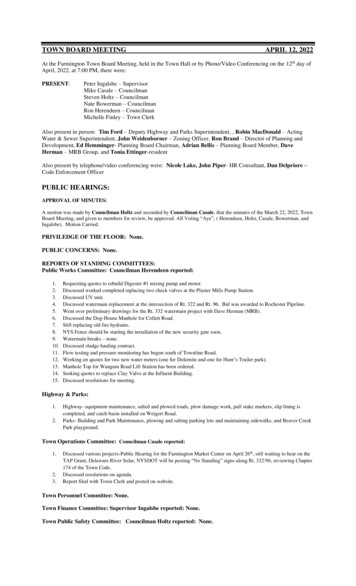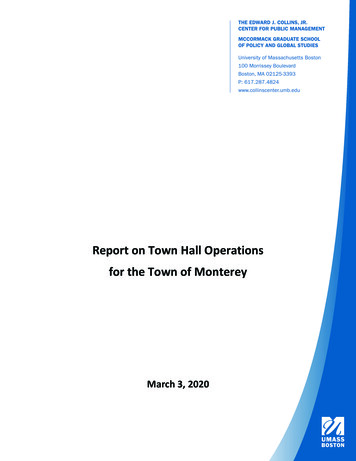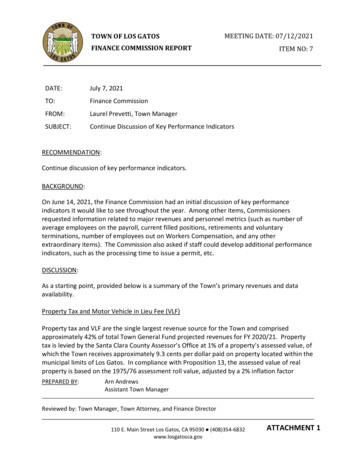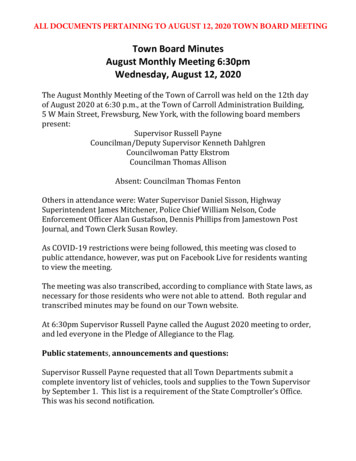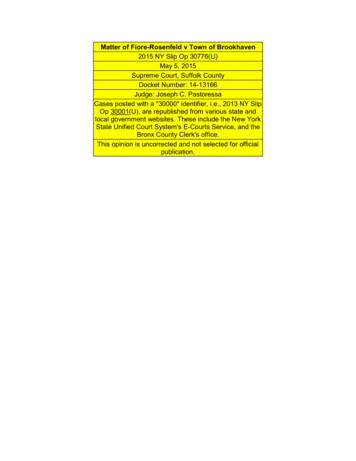
Transcription
TOWN OF WEYMOUTHFINANCIAL MANAGEMENT STRUCTURE A Community Compact Cabinet InitiativeFEBRUARY 2017
PREPARED BY:DLS Technical Assistance Bureau100 Cambridge Street, Boston, MA 02114www.mass.gov/dlsZack Blake, Chief, Technical Assistance BureauTara Lynch, Senior Project Manager, Technical Assistance BureauMarcia Bohinc, Project Manager, Technical Assistance Bureau
Michael J. HeffernanCommissioner of RevenueSean R. CroninSenior Deputy CommissionerFebruary 15, 2017The Honorable Robert HedlundMayor, Town of Weymouth75 Middle StreetWeymouth, MA 02189Dear Mayor Hedlund,I am pleased to present the enclosed financial management structure review for the Town ofWeymouth as part of the Baker-Polito Administration’s Community Compact Cabinet initiative. Thiscollaborative program strives to create clear mutual standards, expectations, and accountability forboth the state and municipalities. It is my hope that our guidance provides direction and serves as aresource for local officials as we build a better government for our citizens.If you have any questions regarding the report, please contact Zack Blake, Technical AssistanceBureau Chief, at 617-626-2358 or blakez@dor.state.ma.us.Sincerely,Sean R. CroninSenior Deputy CommissionerSupporting a Commonwealth of Communitiesmass.gov/DLS P.O. Box 9569 Boston, MA 02114-9569 (617) 626-2300
INTRODUCTIONAt the mayor’s request, the Division of Local Services Technical Assistance Bureau (TAB) reviewedthe Town of Weymouth’s financial management structure. To fulfill a separate request, TABrecently developed and presented Weymouth officials with a set of financial policies, which canserve a complementary function with this report. Both projects were sponsored through theCommunity Compact Cabinet (www.mass.gov/ccc), whose mission is to encourage best practicesthat promote efficiency, accountability, and transparency in municipal government. A wellconstructed financial management framework provides foundational support to reinforce bestpractices related to policies, internal controls, service effectiveness, and resource efficiency.To assess the structure of Weymouth’s department of municipal finance, TAB documented how itsemployees’ duties and responsibilities are currently assigned and executed based on informationconveyed in interviews by the individuals themselves. These were evaluated in relation to statutoryrequirements, internal control standards, and goals of efficiency and effectiveness. Additionally, weexamined the framework of reporting relationships, the quality of existing coordination andcommunication among staff, and the adequacy of safeguards for service continuity.Although overall we found the town’s finance employees to be dedicated and hard-working, thereis significant room for improving procedures, reducing inefficiencies, and enhancing theeffectiveness of the services that department staff provide to taxpayers, to each other, and to othermunicipal employees. The guidance provided in this report is intended to present a path forwardtoward a stronger and more effective financial management team.COMMUNITY PROFILEThe Town of Weymouth is a suburban, South Shore community situated on the extended, OuterHarbor stretch of Boston Harbor. Weymouth maintains a small-town feel despite its sizeablepopulation of 55,419, which is significantly larger than all other communities in the southern MetroBoston area, with the exceptions of the considerably bigger cities of Quincy (pop. 93,494) andBrockton (94,089). This distinction means the town has few, if any, true peer communities in itsregional area with which to make comparisons or benchmark achievements.Given the town’s size, Weymouth has a correspondingly large annual general fund budget, which infiscal year 2016 was just under 176 million. This budget funds a rather full array of programs andservices, among them police, fire, health, recreation, libraries, and harbor-related services. It alsofunds public education for all grade levels through the Weymouth School District and for studentswho attend the Norfolk County Agricultural High School. Additionally, the town provides residentsand businesses with water, sewer, and rubbish utility services through separate enterprise funds.1
In FY2016, the property tax levy accounted for about 54 percent of the town’s general fundrevenue, while the rest came from local receipts (22 percent), state aid (21 percent) and othersources (3 percent). As for expenditures, in FY2015 when the latest data was available, Weymouthspent about 42 percent of its general fund budget on education, 13 percent on public safety, 9percent on fixed costs, 7 percent on debt service, 7 percent on public works, 3 percent on generalgovernment, and 19 percent on other costs.Providing context for Weymouth’s budget capacity and decision making are its community wealthmetrics. The town’s per capita equalized property valuation in 2014 was 111,924, well below thestatewide average of 153,841. Its per capita income as of 2012 was 30,221, which is only about78 percent of the 38,993 average statewide. The town’s average single-family tax bill in FY2017 is 4,270, which is 39 percent below the 6,993 average of its fellow Norfolk County communities.Although the percentage of commercial and industrial property in town (15.3) roughly correspondsto the state’s average, to mitigate some tax burden on residents, Weymouth has a split tax rate. ForFY2017, thesplit is 12.81 per 1,000 on residentialvaluationsand 20.20 oncommercial/industrial/personal.Since 2000, Weymouth’s governing structure has been organized under a Plan B charter as definedin M.G.L. c. 43, §1. The government therefore essentially operates as a city despite the charter’sretention of “Town of” in the community’s name. Weymouth’s elected mayor, serving four-yearterms, acts as the town’s chief executive and primary policymaker. Additionally, the mayor appointsall department heads except for the town auditor and town clerk, who are appointed by the towncouncil. The town council functions as Weymouth’s legislative body and is comprised of five at-largeand six district members serving two-year terms.FINANCE DEPARTMENT BACKGROUNDIn addition to establishing a city government structure, the 2000 charter created a department ofmunicipal finance, which consolidated the accountant, procurement, treasurer-collector, andassessing departments while preserving them as subdivisions. To oversee the department, thecharter established a chief financial officer (CFO) with the latitude for the position to exist as astandalone title or be combined with the treasurer, collector, or treasurer/collector role. In theyears leading up to 2016, this had been a CFO-treasurer/collector position. Until 2016, thedepartment also had an assistant treasurer and an assistant collector, who separately supervisedthe two halves of the combined treasurer/collector division.Due to cramped working conditions, in 2003, a decision was made to move some financedepartment staff from town hall to the McCulloch Building on Green Street, 1.5 miles away. Interms of job functions, the choices over which employees were assigned to which locations changed2
in the interim years, but by the end of 2015, the only positions still working at town hall were theCFO, the assistant collector, and four clerks. These “collector clerks,” as they are often referred to,in fact perform tasks not related to collections, including processing treasury turnovers and exciseabatements and providing basic, assessing-related customer service to walk-in customers. One ofthese clerks is officially assigned on a part-time basis to work at Green Street in the assessingdepartment, although in actuality, she reports there only on rare occasions. There is also a financialassistant in the treasury division who is considered a part-time assessing department employee.When the current mayor began his term in January 2016, one challenge he faced was bringing longterm stability and continuity to the finance department, which had seen much turnover in highlevel positions in the prior two years. Most critically, the mayor started his tenure without a CFO, asthe last CFO-treasurer/collector had resigned in June 2015, and the town had yet to find a suitablereplacement. Additionally, there was a fresh vacancy at the assistant treasurer position.Fortunately, the assessing division had experienced a smooth transition when its assistant assessorwas promoted to principal assessor upon that incumbent’s retirement in 2015. More problematicwas the situation on the collections side of the treasurer/collector division, since the town had notanticipated the departure of the last assistant collector in early 2014 and did not have a qualified inhouse successor. Although the assistant collector whom the town hired in March 2014 had someprior municipal experience, it had been in treasury operations, and so he faced a learning curve forhis new role in Weymouth.The mayor and his chief of staff viewed the inherited vacancies as a good opportunity to reassessthe existing structure, which provided impetus for this project. However, they made some decisionsbefore this project’s completion. First, the town posted the CFO job as a standalone title and hiredthe current officeholder effective June 27, 2016. To create a more vertical alignment, the mayoralso decided to post the new job titles of treasurer/collector and assistant treasurer/collector.These were posted after the new CFO started working in Weymouth because the charter grants theCFO the power to appoint “a Treasurer [and] a Collector,” subject to the mayor’s consent.In August 2016, the CFO promoted a treasury financial analyst to the treasurer/collector position.From March to June 2016, this person had served as interim CFO-treasurer/collector, although byhis own account, an absence of prior mentoring hindered the transition to that role and to his newone. He now splits his time between town hall and the McCulloch building. In December 2016, theCFO promoted a treasury-side financial assistant to backfill the vacated financial analyst position.Also in December, the CFO hired an external candidate for the assistant treasurer/collector positionand eliminated the former assistant collector position.3
Another recent change to the finance department’s structure relates the town’s chief procurementofficer, whose official job title is contract administrator. To bring more focus and formality to thetown’s capital planning, the mayor created the department of capital assets and, in doing so,transferred the contract administrator from finance to this new department in the fall of 2016.The result of the changes in 2016 is a finance department organized as depicted below. The staffprimarily assigned to town hall are highlighted in blue, while those in white work at Green Street.Current Finance Department ollectorTreasury-focused staffCollections-focused staffAssistantAssessorFinancialAnalyst2 FinancialAssistants3 FinancialAssistants(1 vacant)Secretary toAssessors4 PrincipalClerksThe finance department uses Munis financial software to maintain the general and subsidiaryledgers and the receivable controls for taxes, excise and utilities. Munis is also used to generate thebilling files for all committed receivables, to manage purchase orders, and to process weeklypayroll. Since 2016, the annual budget process has been coordinated in Munis under the directionof the mayor’s chief of staff. For its computer-assisted mass appraisal system, the financedepartment uses PK, provided under contract with the PK Valuation Group.4
PROPOSED FINANCIAL MANAGEMENT STRUCTUREIn Weymouth, a variety of factors have inhibited the finance department’s achievement of its fullpotential. In particular, the decision to split personnel into two buildings was counterproductive toteam cohesion, operational oversight, and service delivery. Additionally, a lack of priority onprofessional development created vacuums in institutional knowledge and left untapped the talentsand energies of many employees.Since beginning work in Weymouth, the new CFO has made some progress in reversing theseadverse trends. Payroll was a prime example of a critical duty that had been grossly underaddressedfrom a managerial standpoint. While a few town and school employees do weekly, basic payrolldata entry, for quite some time, Weymouth had only one (treasury) person trained in the higherlevel tasks needed to complete payroll processing. This represented a significant risk to the towndue to the increased legal liability of delayed payroll disbursements. It also meant that no one couldproperly review her work for potential errors or fraud. As one of his first tasks, the CFO made surethe new treasurer/collector was fully trained to back up these payroll responsibilities. He alsointends to see to it that another staff member is trained to provide a third level of back-up, mostlikely the person to be hired to backfill the vacant financial assistant role.The new CFO recognizes the hindrance that distributing employees into two buildings imposes toeffective financial management and has advocated reuniting them. Additionally, he is activelyworking to ensure that department managers have access to the meetings and trainings of theirrespective professional organizations (e.g., the Massachusetts Collectors and TreasurersAssociation) and to other professional organizations, such as the Massachusetts GovernmentFinance Officers Association. Attending these events helps employees gain concrete, functionalinformation, hear about new practices developing in their fields, and interact with peers toexchange practical tips, all of which they can in turn pass on to coworkers.Building on these efforts, we believe that making certain structural changes and altering somepractices will help the finance department better maximize efficiencies, ensure procedures complywith statutory requirements and sound financial controls, and assure effective service continuity.The chart on the following page illustrates the new configuration that would result from ourproposals.5
Proposed Finance Department ollectorAsst Accountant/PurchasingAgentCollections-focused staffTreasury-focused staffAssistantAssessorFinancialAnalyst2 FinancialAssistantsFinancialAssistant3 FinancialAssistantsSecretary toAssessors3 PrincipalClerksExpand the CFO’s RoleThe mayor’s decision to divorce the CFO title from its former treasurer/collector role makes a gooddeal of sense because a community as large and complex as Weymouth warrants a standalone CFOposition. Removing responsibility for performing everyday treasurer/collector duties grants the CFOmore time to provide in-depth fiscal analyses to town decision makers, to develop the professionalskills of finance staff, and to better monitor the performance of the department’s subdivisions.The CFO has yet to be assigned with the full range of responsibilities typical of the position,however. Based on conversations with officials, the town does not anticipate assigning the CFO withprimary responsibility for engineering the annual budget process or for maintaining the capital plan.No one is better positioned to provide policymakers with insight into fiscal trends than the personcharged to oversee the town’s day-to-day finances. And although there is reasonable logic to createa department comprised of personnel with infrastructure expertise to manage the town’s capitalassets, the fiscal planning for capital needs is more appropriately the domain of the central financialexpert. Moreover, a CFO granted true, formal oversight of town finances creates greateraccountability over Weymouth’s fiscal health, and assigning these responsibilities helps to justifythe position’s compensation as a standalone title.6
We therefore recommend the town establish a formal job description that restores to the CFO theduties of directing the budget process and overseeing the annual and long-range capital plan. Sixmonths into the new CFO’s tenure, no job description had been created. However, these dutieswere included in the last CFO-treasurer/collector job description created in 2010. In addition to allthe duties listed in 2010, we suggest that a new job description also include the following: Ensure timely compliance with internal and external reporting Maximize efficiencies in the finance department and identify cost-saving opportunities Oversee procurement operations Develop, implement, monitor, and report to the mayor and town council on correctiveaction plans in response to management letter citations by the independent auditor Participate in collective bargainingBased on conversations, it appears that finance department staff received little direction andprofessional development from prior managers. We therefore encourage the CFO to take on a moreenergetic, skill- and team-building role than might have been necessary in prior communities he hasworked in. Consistent themes noted in interviews were a lack of mentoring, poor understanding ofhow roles fit within the department’s mission, uncertainty of some internal controls, and a sense ofarbitrariness in management decisions. Customer service concerns, both internal and external,were also raised. Its low priority is illustrated by the lack of contact information for many financeofficers on the town’s website, as well as the location of two-thirds of finance staff at the back of abuilding that lacks guiding signage and is otherwise devoted to the town’s senior center.In addition to taking a more hands-on management approach generally, we suggest the CFO beginscheduling regular monthly meetings of a financial management team comprised of the threedivision managers. The CFO can use this forum to ensure that everyone understands their goals andobjectives and to receive updates on them. Further, these meetings can be used to developfinancial analyses, explore the financial impact of future events, and offer early strategies to dealwith anticipated problems. A less obvious, intangible benefit is the delivery of importantinformation to all parties at the same time. In addition, a financial team helps reinforce institutionalcontinuity during times when officers leave their positions.Reintegrate the Treasurer/Collector DivisionThe creation of the treasurer/collector and assistant treasurer/collector titles in 2016 enabled thatdivision’s structure to become more vertical. One positive effect of this was a reduction in the CFO‘sdirect reports, which thereby frees up more of his time. However, we urge the mayor and CFO totake further steps to effectively reintegrate the personnel and functions of this unit. First and7
foremost, high priority should be given to situating all the division’s employees in one building,preferably town hall.One main purpose for consolidating treasury and collection operations is to maximize economy-ofscale efficiencies in managing cash in the two highest volume departments. This benefit issquandered if the staff, transactions, and related materials are split between two locations.Additionally, the internal controls associated with receiving, verifying, posting, and depositingreceipts, whether tax payments or departmental turnovers, are the same. Having these tasks takeplace in one location with staff working side-by-side under a hierarchal management presence isthe best environment to ensure all appropriate controls work effectively in this high risk area.Furthermore, bringing these employees together in the same building would allow more on-the-jobcross-training, expand back-up staffing during absences and high-volume periods, and reduce themanagement silos that can inhibit mentoring relationships. In truth, these would be benefits for thefinance department as a whole, but unless and until all divisions can be housed in the samebuilding, the treasurer/collector reunification should take place as soon as practicable. Movingtreasury personnel to town hall (versus collectors to Green Street) has a secondary advantagebecause of the interactive relationship between the treasury’s payroll processing duties and thepersonnel management tasks of the human resources department, which is housed at town hall.Having greater numbers of the treasurer/collector staff cross-trained and working together in onelocation should help minimize risks and improve efficiencies in many key tasks. There is room forimprovement on collection rates, which have been trending at approximately 96 percent in the lastfour years. Less pressing but nonetheless telling, multiple employees reported confusion as to theresponsibilities for resolving checks returned for nonsufficient funds. Additionally, there is a backlogin completing tax takings that needs to be addressed, which is further discussed later in this report.Finally, it is worth noting that all the collections-focused workers are clerks, while all the treasuryline staff have higher-level financial assistant or analyst titles. The lack of a collections-related lineposition above clerk-level underestimates the portion of the day-to-day workload that requires agreater degree of knowledge and expertise to perform most effectively. Along with the functionalbridge created by relocating all the treasurer/collector staff back together, converting a collectorclerk to a financial assistant would help to build a career ladder and develop succession plans,which have been lacking in the finance department overall.Establish an Assistant Accountant/Purchasing Agent PositionFor multiple reasons, we advise the mayor to consider transferring the contract administrator backinto the finance department. Doing so would not only further develop the finance department’s8
career ladder, but it would also reflect the structure outlined in town charter and help to increaseefficiencies and functional back-ups in the accounting department.Article 5, sec. 4 (1) and (2) of the town charter places the chief procurement officer title in thefinance department. In addition, town ordinances 3-326 (a) and (b), state that the finance directorappoints the town’s purchasing agent, who is responsible for purchasing all supplies for everydepartment and ensuring all contracts comply with M.G.L. chapters 7, 30B, and 149. Modifying acharter is more complicated than revising ordinances, but in this case, we believe the framers of thecharter were wise to place central procurement oversight responsibility within the financedepartment. Notwithstanding the spending authority granted to department heads, M.G.L. c. 41 §56 authorizes the town accountant to assure that all departmental appropriations are adequate tosupport purchases and that all expenditures are lawful, which includes verifying their compliancewith state procurement laws. It is more efficient to have these reviews take place within a singledepartment. Additionally, setting procurement oversight apart from a capital managementdepartment that would be expected to enter into many contracts and to do an especially largeamount of purchasing provides a good check and balance.Although the current contract administrator position is roughly at peer-level with the accountant,as a long-range plan, we suggest the town create a position under the town accountant with thetitle of assistant accountant/purchasing agent. When there is turnover in this position, this can helpaddress a lack of succession planning in the accountant division. In the past year, the town activatedthe Dashboard procurement application within Munis, which will ultimately result in significantstreamlining of the purchasing process and reduction of associated paperwork. The worktimethereby freed up for the incumbent in this position can be devoted to other accounting-relatedtasks, such as assisting with reconciliations. The person holding this dual title should be trained andauthorized to act as town accountant during absences in that position.Prioritize Training and Professional DevelopmentA more proactive and systematic approach than has existed in the past is necessary if the townwants to make real gains in employee professional development. By investing time, energy, andfunds, the department can improve customer service, delegate tasks appropriately, and plan forsuccessions. The former, less encompassing approach resulted in assistants inadequately trained tostep into superiors’ roles during absences or as potential future officeholders and a structure withill-defined roles for maximizing efficiency on a day-to-day basis.To correct this, we suggest the CFO begin by compiling a top-to-bottom inventory of tasks that mustbe completed to achieve the department’s objectives, along with the skills and knowledge neededto perform them. He should then map out a hierarchical, interdivisional structure for carrying out9
these tasks. The CFO should meet with employees individually to discuss their present skills andknowledge gaps to get a clearer picture of training needs. In addition to using this skills inventory toschedule formal training sessions for staff, the CFO should actively schedule periods of time foremployees within divisions to rotate tasks. As another by-product of these efforts, the CFO shouldwork with the human resources director to create updated job descriptions for all financedepartment employees.Reestablish Segregation of Duties between the Assessing and Treasurer-Collector DivisionsIn our proposed organization chart, the dotted lines connecting the assessing department to twoemployees in the treasurer/collector division have been removed. At some point in the past, aformer CFO decided to create this arrangement by assigning part-time, assessing-related duties tothese employees. However, basic considerations of incompatible duties should dictate a hardfunctional separation between assessing activities and those related to financial transactions. Noone who works in an assessing capacity should have capabilities to make changes to a receivablecontrol or to process refunds, which tasks lay squarely in the treasurer/collector’s domain. M.G.L. c.41 §24 prohibits an assessor from simultaneously serving as a collector, so it follows that thereshould be no commingling of roles by any employees working in either area. Furthermore, based onemployees’ descriptions, rather than treasurer/collector staff making adjustments in Munis basedon notifications of real estate exemptions and excise abatements received from the assessingdivision, the process happens in reverse.Accordingly, the tasks of receiving, reviewing and approving real estate exemptions should beassigned away from the treasury financial assistant who currently does them and back to theassessing office. The only exemption-related task any treasurer/collector employee should performis making credit adjustments after receipt of exemption reports from the assessor’s office. As acorollary to this advice, the CFO should work with the town’s information technology director toensure that the Munis and PK user permissions for all finance department staff are strictly limitedto what is necessary to perform their jobs and comply with sound segregation-of-duty principles.Revise Excise Abatement ProceduresFollowing on the last recommendation, interviews and documents gathered during this projectrevealed the need to revise motor vehicle and boat excise abatement practices. At present, aresident seeking an abatement applies in person at the collections office at town hall. If a clerkthere approves the abatement, she issues the resident a division-created receipt with the reasonfor abatement written on it. The accumulated receipts and associated supporting documents (suchas bills of sale) are sent regularly via interoffice mail to the treasury office at Green Street. Afinancial analyst there reviews the paperwork, makes credit adjustments to the Munis accounts of10
the approved applicants, and generates refund checks if payments had already been made. Theanalyst then runs a summary Munis report of the abatements, which she delivers to the assessors’office and files in a binder there. She then sends the receipts and supporting documents back to thecollector’s office by interoffice mail.This system lacks strong controls. The collector’s office keeps no log of the abatement activity, noteven a prenumbered, duplicate-copy receipt book. Furthermore, the transmitting of abatementreceipts and supporting documents back to town hall as soon as the Munis abatement report hasbeen delivered to the assessors’ office does not allow for proper validity reviews by the assessingstaff and board. Apart from these flaws, this system must be changed because MassachusettsGeneral Laws do not allow an excise to be abated prior to receiving a formal approval by the boardof assessors. Further, the current procedures do not require an abatement applicant to provide aplate return receipt from the Registry of Motor Vehicles, which is also statutory requirement. Torectify the process, we advise the CFO to institute the following changes: Implement State Tax Forms 126-MVE and 126-BE as the only means for applying forabatements and make them available for download on the assessing division’s webpage.Both come in long and short forms and can be found on the DLS website l-finance-law/forms-and-brochures.html. Create a formal, written set of abatement procedures appropriately delineating the relatedtasks and retrain the assessing and treasurer/collector staff. After assessing staff accept abatement applications and make preliminary assessments onthem, the principal assessor should present her recommendations to the assessing board. Upon approvi
Munis is also used to generate the billing files for all committed receivables, to manage purchase orders, and to process weekly payroll. Since 2016, the annual budget process has been coordinated in Munis under the direction of the mayor's chief of staff. For its computer-assisted mass appraisal system, the finance
